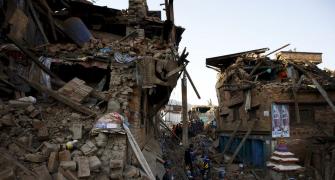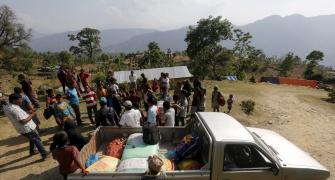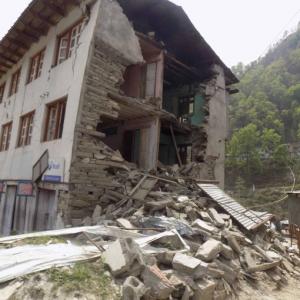On April 25 2015, a massive earthquake in Ghorka, Nepal, followed by another devastating one on May 12, killed nearly 9,000 people and injured over 21,000. More than 600,000 homes were damaged or destroyed.
Two years later, the paved alleys are still lined by the skeletons of homes once filled with families. Children carefully side-step piles of broken brick on their way to school.
According to data available, barely 5 per cent of the destroyed houses have been rebuilt, according to the National Reconstruction Authority. That 800,000 families still do not have their houses rebuilt is simply a disaster.
Here’s a look at Nepal, which is still trying to rebuild itself.
All photographs: Navesh Chitrakar/Reuters

A man walks out from his house, which is under construction, after the old house collapsed during the 2015 earthquake, in Bhaktapur, Nepal. According to latest figures, around 800,000 families are still homeless.

When the quake struck Nepal, the country lost a large part of its cultural heritage with several UNESCO structures being struck down. One of Kathmandu's most famous landmarks, Dharahara tower was built in 1832 after being commissioned by the Queen. Standing at 70 metres tall, its collapse during the quake resulted in the deaths of 132 people, the highest recorded casualty figure at a single site.

Over 800 of Nepal’s ornate temples, palaces and monuments were severely damaged or completely destroyed in the quake. Two years later, workers are hard at work trying to reconstruct their heritage.

Shortly after the disaster, $4.1 billion was raised for the reconstruction of the country. However, progress has been painfully slow for families who have now spent two winters without proper shelter. Many live in makeshift huts and bamboo tents.

Piles of rubble from destroyed homes still line the streets of Nepal. As of April 6, according to the National Reconstruction Authority, just 20,899 houses were rebuilt, forcing thousands to live on the streets, out in the cold, making them more vulnerable to diseases and sickness.

Denied adequate housing, earthquake survivors have acquired other problems over the past two years, including high debts. Furthermore, living in informal shelters has put people at risk of grave health consequences, including respiratory illnesses, and injuries from snake bites.

A labourer sits on top of the debris of a monastery damaged during the 2015 earthquake, in Swayambhunath Stupa, a UNESCO world heritage site in Kathmandu.










